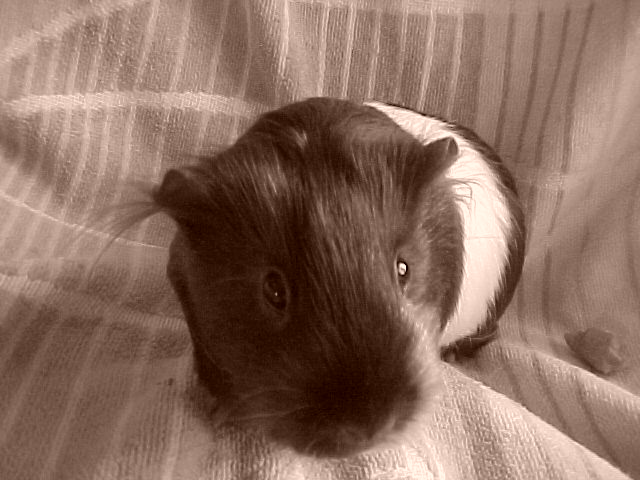
| Kingdom - Animalia | Suborder - Hystricomorpha |
| Phylum - Chordata | Family - Caviidae |
| Class - Mammalia | Genus - Cavia |
| Order - Rodentia | Species - C.porcellus |
A Breif History
The domesticated guinea pig has been bred for meat production in South America for at least 3,000 years. During the period of the Inca Empire (from about 1200 to 1532) highly selective breeding happened so to get different color patterns and meat flavor, producing a wide variety of guinea pig strains.
The guinea pig was brought over to Europe in the sixteenth century, and since the mid 1800s have been used in labratories everywhere for research on nutrition, pathology, toxicology, genetics, and the development of serums.
Once believed to be a rodent, the cavy (guinea pig) is now thought by many evolutionary biologist to belong to a seperate order, as reported by the Associated Press in the early 1996.
Is it a pig? Is it from Guinea? What's with the name?
No it is not a pig, nor is it from Guinea; the actual reason for the name is unknown. There are a few guesses for how it got its name; like how the domestic guinea pigs' species name is porcellus (C. porcellus), what means "little pig" in Latin. The only other similarities to pigs are the low grunts, the squels they make when they're hungry, and their chubby little bellies!
But then there is the theory that "Guinea" is taken from the "Guiana" region of South America, which is home to an animal simular to the guinea pig. Others tell tales of British sailors who sold the animals (who made sounds similiar to those of a frightened pig) for the price of one guinea.
Some Breeds
Housing
Guinea Pigs need a cage that is atleast 14 inches by 24 inches by 10 inches high (for one guinea pig). The cage usually has a plastic bottom that is three-four inches deep and has verticle wire bars for the upper part (the plastic bottom can be removed for easy cleaning.) Guinea Pig cages can be bought at most pet stores.
Fill the cage with wood shavings, small animal litter, straw (that has not been treated with growth inhibitors) and/or pine bedding. *You can even put some cat litter in to reduce oder.*
Guinea Pigs do not require tops on their cages; the usually will never climb out.
I do not recomend a sood bottom for guinea pig's cage because it will soak up urine and the smells of urine, even though it is cheap.
They feel the best when they're in a little house, with a "roof over their head." This house can be made of pine, fir, or larch wood; plastic, plywood and fiber board should not be used, because they are poisionous to guinea pigs.
Handling
You should grasp the guinea pig firmly around the front shoulders with one hand and support its rear with your other hand.
To carry a cavy (guinea pig) you should place one hand under their belly and grasp it firmly, so it doesn't fall, on its back. For more security, hold the guinea pig against your chest with both hands, one on its back, one under its butt.
Feeding
Guinea pigs are vegetarians. Theri basic food is hay, and they love green, "juicy" food. There is guinea pig pellets that contain all the necessary nutrients and vitamins (such as vitamin C).
They like fresh fruit and vegetables, also dandelions, as treats, and a regular in their diet.
Potato peelings and raw beans are poisonous to guinea pigs. Iceberg lettuce, green cabbage, Chinese cabbage, cauliflower, and red cabbage should rarely be given, and when they are it should be in very small amounts.
Reproduction
Females sexually mature at five to six weeks; males mature at nine to ten weeks.
Guinea pigs should be allowed to court. Yes, I said court, they make strong bonds together, and so you need to make sure they like one-another.
The heat cycle in sows (females) useually lasts about sixteen days (on average.) And will come into heat just twenty-four hours after giving birth.
Females con produce, on average, two to four litters each year.
Birth frequently occurs in the day-time, and lasts for ten to thirty minutes. Guinea pig babie's eyes open fourteen days before they are born, they also have their teeth and a full coat of hair.
The young can be seperated from the mother at five weeks, but they should be seperated, depending on ther sex, at four weeks.
Health
Especially when special care is taken to eliminate any major changes in temperature, drafts, and humidity, the guinea pigs are and will stay healthy.
Guinea Pig Links
Todds Guinea Pig Hutch
Guinea Pig Diseases
Small Animal Medley
Net Vet- The Electronic Zoo --Rodents
The Ultimate Guinea Pig Links Page
The Guinea Pig Compendium
Angelfire - Easiest Free Home Pages
Special Thanks To/ Resources:
Guinea Pigs by Katrin Behrend. And Small Animal Care & Management by Dean M. Warren.